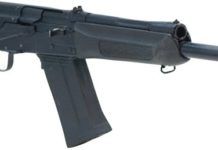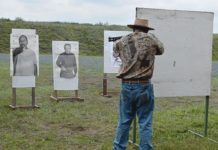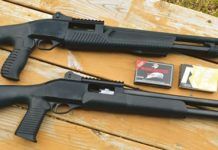This over/under match-up has a distinctly international taste to it. We recently pitted a Belgium-made gun with an American name-the Winchester 101-against the all-American Ruger Red Label engraved model, the increasingly popular Caesar Guerini representing the Italian trigger-plate actions, and Brownings most recent stackbarrel, the Japanese-made Browning-branded Cynergy. All are marketed as general-purpose models suitable for hunting and casual clays use.
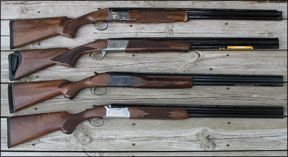
In more detail, they were 3-inch-chamber 12 gauges that would likely be the most expensive shotgun 95% of us might own. The smallest price tag came on the Winchester Model 101 Field No. 513046361 3-inch 12 gauge, $1739. It is Belgium-made by F.N., the country and manufacturing facilities that J.M. Browning turned to originally when he was dissed by the old Winchester in the very beginning. This “101” is related to the Olin-Kodensha 101 is its name and styling attempt only.
Next up was the Ruger Red Label Engraved No. KRL-1227-BRE 3-Inch 12 gauge, $2180. This Red Label comes with scroll-engraving and gold-inlaid pheasants adorning both sides of the stainless-steel receiver. What we quickly noticed about this model was both the engraving and the wood. Contrasted with the sleek, smooth look of the base models stainless receiver, the engraving dresses the gun up. Also, the well-figured wood elements in the forearm and the buttstock matched in color and tone, and the checkering was deeply and crisply cut, making the furniture functional as well as visually appealing. If this were an import, you might have to add an “E” or an “L” to describe its wood quality. You also wont have to worry about a plated finish chipping off or flaking, nor will you ever see any receiver bluing wear. Stainless steel has its benefits.
The next step up in price was the Browning Cynergy Euro Field 3-inch 12 Gauge No. 013297304, $2609. To oversimply the reason for the Cynergy, it is Brownings effort to produce the lowest-profile over-under shotgun ever made. Theres a very good reason for pursuing this design-the lower barrels are set into the receiver, the less muzzle rise you are going to have. In our view, Browning succeeded in its goal of producing a low-profile design.
The most expensive gun in the test was the Caesar Guerini Tempio, $3195. It had a low-profile receiver, Prince-of-Wales grip, and schnable fore-end. The receivers “French grey” metal finish is a nickel alloy underlying full-coverage scroll engraving featuring Bulino-style gold game scenes. The Tempio also features a deluxe grade of Turkish walnut with a hand-rubbed oil finish.
With the stage set, we set out to find if the Tiempo could possibly be worth a $1400 price premium between it and the Winchester, worth $1000 more than the Red Label, and almost $600 more than the Browning. Heres what our team found:
Caesar Guerini Tempio
3-Inch 12 Gauge, $3195
The CG style of over/under is similar to the better Battista Rizzini models. It is the sleek Italian triggerplate action that has found favor with many.
The tested CG Tempio came equipped with an option we werent looking for, the “DTS kinetic balancer,” which is a more elegant way to balance your shotgun the way you prefer. It is certainly more elegant than gluing in alternator brackets and the like. Out of the box, the Tempio weighed in at 7.8 pounds with the installed balancer. We didnt like the buttstock-heavy feel the balancer gave the gun, and it rattled a bit, as you might expect from sleeve weights held between springs retained in place by set collars. We could not wait to remove the balancer; thats the first thing we did, giving the CG Tempio a 7.5-pound unloaded weight, with neutral balance. In any case, the DTS kinetic balancer came installed in the gun, but it actually is a $145 option. For field and casual clays use, we wouldnt get the balancer as an option. For a longer-barreled dedicated clays gun with a heavier, wider rib and barrel set-it may be desirable.
We liked the distinct mineral streaks in the wood of the CG and the extensive checkering present on the forearm-essentially wrap-around checkering. The buttstock had a palm swell in the pistol-grip area, another touch we welcomed. Visually, it makes both the Cynergy and 101 shotguns look pretty sad. We note that unless otherwise requested, the companys field guns come with a wood buttplate-a notion virtually guaranteed to punish the shooter. Insist on a recoil-pad-equipped stock similar to the one tested here.
According to our team, the Guerinis receiver was the most attractive of the tested guns, a pleasant dark-gray finish with sharp scroll work that helped the gold-inlayed birds on both sides of the receiver and the bottom stand out nicely. The tasteful scroll work didnt end at the receiver, either-we thought the trigger guard was extremely well-done as well.
We found the CG tang safety to be overly stiff; it was hardly effortless to get off. In fact, for field use with cold or gloved hands, the button gave the thumb scant purchase to take off the safety, but a generous, prominent, steep ridge to put it back on-the opposite of what we would prefer. Only the Cynergy got it right as far as we are concerned. Caesar Guerini offered to lighten the safety under its customer service plan. The gun went back to CG, and they turned it around with lightning speed. According to Wes Lang of CG, the standard CG safety was modified at the behest of clays shooters, who were accidentally switching barrels with its more prominent center slide “barrel-selector” section. So what CG did was go back to the original safety style on their field guns-and that is the safety that was installed on our test gun and returned to us. It was much easier to get off, even though the profile didnt change much. But CG lightened the safety, so it was dramatically better than as originally supplied.
We continued to find a lot of value in the Tempios presentation. Where the Winchester and Browning shotguns were a skimpy in the choke department, CG provided five flush-mount choke tubes with the Tempio. The CG Tempio also came in a very good combination-lock equipped red-flocked case-where the rest of the shotguns were shipped in cardboard boxes. (Browning requires a copy of your form 4473 and some paperwork to send you the Cynergy Club case.) They came in an eight-slot hard-plastic choke case suitable for regular or extended choke tubes-another touch the active shooter will appreciate.
Another feature unique to Caesar Guerini is the “Pit Stop Program.” Once a year for three years, the original purchaser can send his CG to Guerini USA for a professional cleaning and tune-up. CG promises a five- to seven-business-day turnaround. This is another benefit that is up to the individual to value. We feel this is a couple of hundred dollars worth of shop labor, and CG pays your return shipping as well.
The more time we spent with the CG, the more we appreciated it.
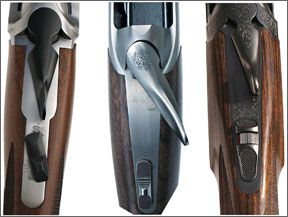
It shot to point of aim with spot-on barrel regulation. The CG had the crispest triggers of the test, breaking right at 5 pounds. Yet another touch we noted and immediately liked was the stippled face of the gold CG trigger.
Our Team Said: Overall, the CG Tempio was an outstanding example of what we think a quality over/under should be. It has the looks, the handling, the triggers, the metalwork, and the overall responsiveness in the field to be a solid notch above most everything else in its price range. Also worth noting are the included hard case, three free “pit stops” of service, and a lifetime warranty. No over-the-counter written warranty comes with the other tested shotguns.
Browning Cynergy Euro Field No. 013297304
3-Inch 12 Gauge, $2609
This gun comes with a package called the Cynergy Club, which does offer some value-a $100 rebate check to start. Also, the Cynergy custom hard case that comes with this rebate package is well-made, has combination locks, and fits the Cynergy superbly. Browning values this rebate package at $500, but it may not be worth that to everyone. Browning also adds a five-year warranty if you join the Cynergy Club. However, the deal is substantial and needs to be noted. It goes a long way toward making the Cynergy a competitive product.
As supplied, the Cynergy weighs in at 7.5 pounds on the nose, less than the catalogued weight of 7.7 pounds. It is essentially a neutrally balanced gun, so we felt it shouldered and swung substantially faster than its weight would lead you to believe. The Cynergys triggers broke at a reasonably crisp 5.25 pounds, not overly light but acceptable. They felt a bit lighter than that to us, due to the wide trigger face. The hope of very light, super-crisp triggers was not totally fulfilled-the Red Labels triggers were substantially lighter and the CG triggers were noticeably more crisp, our testers said.
The face of the Cynergys bulbous “Inflex” recoil pad was smooth and slick. Initially, we felt that might be slick enough to promote unwanted stock slippage, but that wasnt the case. It did make for a quick, snag-free shoulder mount. The Inflex pad had a big gap between the top of it and its mating area on the buttstock. Seems to us if you are going to carve out a piece of buttstock and mold an eccentric-looking pad to fit it-it should fit it properly. We expected better.
Half of our shooters felt the Cynergy styling was modern, while the rest felt it was just overdone geometric styling accents. Though Browning promised a “new gloss oil finish and upgraded Grade II/III walnut,” the gun didnt deliver that, in our view. Though we liked the even chestnut stain, it was not substantially better than the Guerinis or Rugers wood, and the checkering was not as sharp and crisp as the Rugers, we thought. Browning also claims “new full coverage high-relief engraving [that] includes the receiver, forearm iron and top lever” on this model. We did not think it was remotely close to “full coverage,” and the Guerini treatment better matched our cosmetic preferences.
While the Cynergy brags of “1.9 ms locktime,” fast locktime (though preferable) isnt of much tangible value in a shotgun as it would be in long-range off-hand rifle shooting at more or less stationary targets. Although Browning boasts that “this ultra-quick, ground-breaking system will render the old impact-wheel systems found on most other over-and-under shotguns obsolete,” that appears to be wishful thinking. It hasnt obsoleted anything since the Cynergys introduction five years ago. The highest number of shots we could quickly produce remained fixed at just two.
We have no qualms or concerns about the strength or durability of the Cynergy action. Still, the sleekness of the receiver was offset by the cumbersome frame attached to the barrel set used to attach the forearm. The Cynergy shot to point of aim with good barrel regulation. Browning got the tang safety right where Guerini failed-the Cynergy safety was effortless to flick off in a hurry.
Our Team Said: Though well-made, the Cynergy is a weak value, in our view, compared to the Red Label and the Guerini we shot alongside it. As a group, we wouldnt rush to buy it-though one of our shooters did. The Cynergy fit him better than any other over/under model he had tried, so individual fit triumphed over everything else.
Ruger Red Label Engraved No. KRL-1227-BRE
3-Inch 12 Gauge, $2180
The Ruger was a substantial gun, with our sample weighing 7.9 pounds. This mass, even with Rugers thinnish rubber buttpad, made the gun softer-shooting than many other over/unders. The Ruger barrel set is heavy, and thats not all bad. It encouraged our shooters to get the gun down in the shoulder pocket where it belongs. For a field gun, though, we would like to see the Ruger in a lighter form. Losing a few ounces from the barrels would make us far more interested in a 30-inch-barrel version of the Red Label then we are now. For clays or on the dove field, as is is just fine. The RRL also shot to POA with good barrel regulation.
The Ruger had a wide ventilated rib, more of a sporting clays style than a thin field treatment. It fit all of us well, and was smooth to swing and easy to hit with. We found the overall build quality of this Ruger to be rock-solid. It required no strain to break open. Ruger included five choke tubes and a speed wrench.
We liked the Ruger mechanical triggers rather than recoil-switched triggers. In fact, the Ruger triggers broke right at 4.5 pounds, the lightest of the test. They had a small amount of creep, but were still excellent triggers-second only to the Caesar Guerini, in our view.
We dont like the Rugers auto safety-reset. The auto safety can be disabled by a gunsmith (or by Ruger), and thats something wed do to the gun if we bought it. Also, we wish Ruger would change the pivoting barrel selector tang safety to a more conventional slide-selection.
Our Team Said: The Red Label proved to be the sleeper of the test, a very good stackbarrel that offers a lot of value for the dollar.
Winchester Model 101 Field No. 513046361
3-inch 12 Gauge, $1739
This Winchester 101 has a strange history. Because its made by F.N. in Belgium, the case can be made that it is more of a Browning than any Browning over/under shotgun sold in the U.S. in the last 20 years. The action itself is a Beretta-esque affair with the addition of a massive center locking lug. Its predecessors, the Winchester Select and the original Winchester Supreme, never caught on. The styling is changed, but the action remains the same. At this price, you might think that an F.N.-made over/under would be hard to beat. Originally, thats what we thought as well.
Browning had cataloged two different sets of stock dimensions for its current “Select” field models, so we called to check it out. We were informed that the stock design we were testing featured the guns standard dimensions. That was too bad, because it didnt fit our test shooters-it didnt have nearly enough drop. All we saw was rib-rib-rib, so it would take major stock reworking to make this a usable shotgun for any of us. Also, we thought the pistol grip wasnt in the right place, sitting too far forward toward the trigger. It was noticeable compared to the CG, Ruger, and the Cynergy models we shot alongside the 101.
This 101 weighed in at 7.1 pounds, the lightest gun of the test. The buttstock was finished off with a Pachmayr White Line recoil pad, but because of the stock-fit problems, that wasnt nearly enough to make this shotgun comfortable to shoot with 11⁄8-oz. B&P F2 Legend shotshells.
We were also disappointed with the Winchesters triggers. Both had a lot of take up and broke at 6 to 6.5 pounds. Our testers said they liked the other guns triggers better than the Winchesters.
We found the wood to be plain, essentially straight-grained, and adequate-a step down from what Winchester claims is “luxuriously finished high-gloss grade II/III walnut.” The roll engraving on the receiver looked muddy compared to the work on the CG and Ruger guns. Also, where all the other shotguns shot properly to point of aim with good barrel regulation, this 101 did neither. At 20 yards, the patterns from the lower barrel were 4 to 5 inches from point of aim. The upper barrel also shot to the left and high, putting the pattern centers from the upper barrel 3 or 4 inches away from the lower barrels pattern centers at just 20 yards.
Our Team Said: We found the fundamental action to be strong, durable, and reliable. Still, because of the stock fit problems, the heavy triggers, and the point-of-impact problems, our team clearly preferred the other shotguns in the test.



























